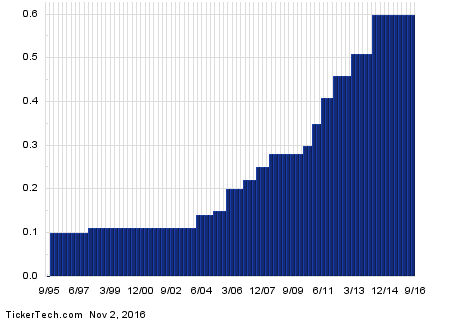Investors eyeing a purchase of Deere & Co. (Symbol: DE) shares, but tentative about paying the going market price of $ 88.60/share, might benefit from considering selling puts among the alternative strategies at their disposal. One interesting put contract in particular, is the January 2018 put at the $ 65 strike, which has a bid at the time of this writing of $ 2.35. Collecting that bid as the premium represents a 3.6% return against the $ 65 commitment, or a 3% annualized rate of return (at Stock Options Channel we call this the YieldBoost ).
Selling a put does not give an investor access to DE’s upside potential the way owning shares would, because the put seller only ends up owning shares in the scenario where the contract is exercised. And the person on the other side of the contract would only benefit from exercising at the $ 65 strike if doing so produced a better outcome than selling at the going market price. ( Do options carry counterparty risk? This and six other common options myths debunked ). So unless Deere & Co. sees its shares decline 26.4% and the contract is exercised (resulting in a cost basis of $ 62.65 per share before broker commissions, subtracting the $ 2.35 from $ 65), the only upside to the put seller is from collecting that premium for the 3% annualized rate of return. Interestingly, that annualized 3% figure actually exceeds the 2.7% annualized dividend paid by Deere & Co., based on the current share price of $ 88.60. And yet, if an investor was to buy the stock at the going market price in order to collect the dividend, there is greater downside because the stock would have to lose 26.39% to reach the $ 65 strike price. Always important when discussing dividends is the fact that, in general, dividend amounts are not always predictable and tend to follow the ups and downs of profitability at each company. In the case of Deere & Co., looking at the dividend history chart for DE below can help in judging whether the most recent dividend is likely to continue, and in turn whether it is a reasonable expectation to expect a 2.7% annualized dividend yield.  Below is a chart showing the trailing twelve month trading history for Deere & Co., and highlighting in green where the $ 65 strike is located relative to that history:
Below is a chart showing the trailing twelve month trading history for Deere & Co., and highlighting in green where the $ 65 strike is located relative to that history:  The chart above, and the stock’s historical volatility, can be a helpful guide in combination with fundamental analysis to judge whether selling the January 2018 put at the $ 65 strike for the 3% annualized rate of return represents good reward for the risks. We calculate the trailing twelve month volatility for Deere & Co. (considering the last 253 trading day closing values as well as today’s price of $ 88.60) to be 26%. For other put options contract ideas at the various different available expirations, visit the DE Stock Options page of StockOptionsChannel.com. In mid-afternoon trading on Wednesday, the put volume among S&P 500 components was 526,679 contracts, with call volume at 640,979, for a put:call ratio of 0.82 so far for the day, which is unusually high compared to the long-term median put:call ratio of .65. In other words, there are lots more put buyers out there in options trading so far today than would normally be seen, as compared to call buyers. Find out which 15 call and put options traders are talking about today .
The chart above, and the stock’s historical volatility, can be a helpful guide in combination with fundamental analysis to judge whether selling the January 2018 put at the $ 65 strike for the 3% annualized rate of return represents good reward for the risks. We calculate the trailing twelve month volatility for Deere & Co. (considering the last 253 trading day closing values as well as today’s price of $ 88.60) to be 26%. For other put options contract ideas at the various different available expirations, visit the DE Stock Options page of StockOptionsChannel.com. In mid-afternoon trading on Wednesday, the put volume among S&P 500 components was 526,679 contracts, with call volume at 640,979, for a put:call ratio of 0.82 so far for the day, which is unusually high compared to the long-term median put:call ratio of .65. In other words, there are lots more put buyers out there in options trading so far today than would normally be seen, as compared to call buyers. Find out which 15 call and put options traders are talking about today .
The views and opinions expressed herein are the views and opinions of the author and do not necessarily reflect those of Nasdaq, Inc.
Plantations International